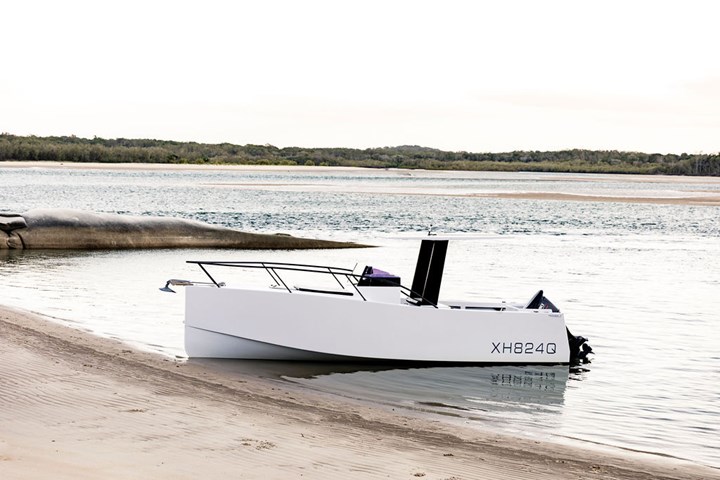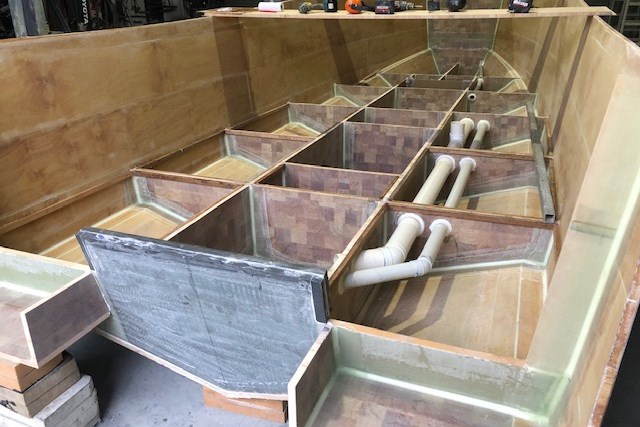ATL Composite panel systems enable Noosa 7 dynamic dayboat design
The Noosa 7 is hand-built and customized using DuraKore and DuFlex composite panel systems, minimizing material waste, tooling costs and simplifying quotations.

All photo credit: Noosa Marine
The team at (Noosa, Australia) has announced that it is crafting the Noosa 7, a seven-meter motor yacht designed by Director Julian Griffiths and said to be only the second unit ever built. The dayboat is constructed using DuraKore and DuFlex panel systems from ATL Composites (Molendinar, Australia) and at 2.3 meters wide x 7.3 meter long, weighs only 1,250 kilograms.
With space for up to eight people, sleeping four in comfort, the Noosa 7 boasts a deck shower and fridge under the helm, and a 140-horsepower Suzuki engine. It is also lightweight enough that it can be transported via trailer.
Noosa Marine’s Julian Griffiths is said to be renowned for his expertise in building multihulls for marine craft using these composite panel systems, including the Schionning G Force 2000 Special (“KATO”) catamaran, as well as the Roger Hill-designed 14-meter AYANA and 19.5-meter BAJACA. Noosa Marine says Griffiths is now focused on promoting his own designs under the Noosa brand.
The Noosa 7 was one such design, and was first built ten years ago. “It was ahead of the times,” Griffith says. The craft is said to be compact, light weight, serves well as a day boat or weekender and is sturdy and stable enough for runs up to Double Island Point and Musgrave Island from Noosa at a top speed of 30 knots. “I built the first one for myself, without plans, just making it up as we went along. For this second one, we’re making plans as we go. A draughtsman is measuring and doing the drawings which will be computerized. Then we’ll get a kit produced from ATL so future boats are a quicker build for us.”
The first Noosa 7 was constructed using DuraKore Strip Planking for the hull, but Griffith says the following models will be made of 100% DuFLEX Composite Panels in CNC-routed kit form. The kit technology minimizes material waste, tooling costs and simplifies quotations.
“DuFLEX is brilliant to work with,” says Griffith. “You can create boats that are quicker, lighter and stronger. Our boats aren’t molded. Instead, they are made by hand, using widely spaced temporary build frames that are CNC- routed from design files to the required shape. Large parts like hull panels are created by bending the flat panels around the frames, ensuring a fair hull shape.”

Build time is approximately four months and the cost of the Noosa 7 with engine and nav gear is approximately $140,000. “This is a hand-built, high-end, epoxy composite product. Unique and one-off, you are buying a custom vessel. It’s not for everybody, but we are hopeful of catering to a niche of coastal cruisers looking for something different,” says Griffith. He adds that Noosa Marine is aiming to build around five to eight per year, depending on labor.
“There’s also a 10-meter version in the works, just waiting for somebody to spot it and make it their own,” he says. The larger model will be priced around $300,000. “It’s more like a super tender, European style with a V8 diesel inboard and the works onboard.”
Owners will also be provided after-sales support. “It’s my name, my pride that go into our boats,” asserts Griffith. “Once you buy one of our boats, you’re in the family.”
Related Content
Composites end markets: Boatbuilding and marine (2025)
As 2023-2024 consumer demand slows, boat and marine vessel manufacturers continue to focus on decarbonization and new technologies using composites.
Read MoreLarge-format AM speeds plug production for manufacture of composite boat molds
Hungarian manufacturer Rapid Prototyping transitioned its conventional foam milling process to 3D printing to produce faster, higher quality, recyclable foam plugs and composite boat molds.
Read MoreHybrid composite architecture enables rigid wind propulsion solution for maritime decarbonization
GT Wings’ AirWing leverages aerospace engineering principles combined with hybrid glass and carbon fiber composite construction to deliver up to 30% fuel savings through compact, deck-compatible wind propulsion.
Read MoreEvolving natural fiber technology to meet industry sustainability needs
From flax fiber composite boats to RV exterior panels to a circularity model with partnerships in various end markets, Greenboats strives toward its biomaterials and sustainable composites vision in an ever-changing market.
Read MoreRead Next
Next-gen fan blades: Hybrid twin RTM, printed sensors, laser shock disassembly
MORPHO project demonstrates blade with 20% faster RTM cure cycle, uses AI-based monitoring for improved maintenance/life cycle management and proves laser shock disassembly for recycling.
Read MoreCutting 100 pounds, certification time for the X-59 nose cone
Swift Engineering used HyperX software to remove 100 pounds from 38-foot graphite/epoxy cored nose cone for X-59 supersonic aircraft.
Read MoreScaling up, optimizing the flax fiber composite camper
Greenlander’s Sherpa RV cab, which is largely constructed from flax fiber/bio-epoxy sandwich panels, nears commercial production readiness and next-generation scale-up.
Read More












